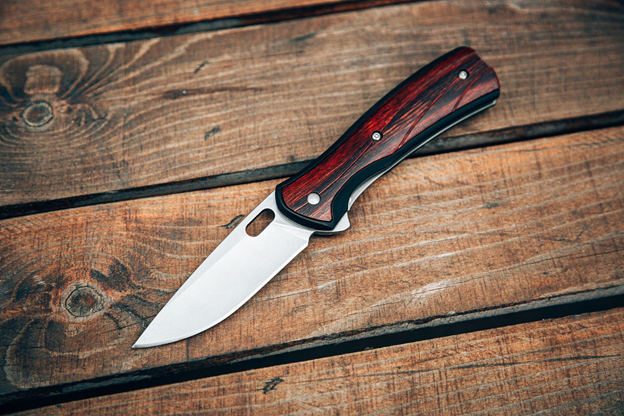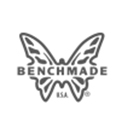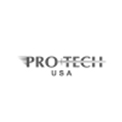Keeping Rust Off Your Folding Utility Knife
16th Jul 2025
When you hear the term folding utility knife, you probably think of something like a box cutter with a retractable design, one that takes disposable razor blades. Or perhaps you think of a pocket knife in a traditional pattern or even a modern EDC folder.
Either way, they all have steel blades, and all steel will rust if not properly cared for, no matter what the alloy is, period.
With that said, this short guide should help you keep the rust at bay. Be conscious of what this article tells you and your folding utility knife will last for longer, with less rust.
Keep It Clean and Dry
This is, far and away, the single most important thing you can do to prevent rust on your folding pocket knife or utility knife.
If you use your knife in conditions that are wet, muddy, gritty or greasy, always clean it thoroughly and dry it before you store it. If you fold it and put it away without drying it, the moisture is eventually going to cause rust where it’s in contact with the blade.
Always make sure you remove all residue and moisture from the blade, but most importantly, you need to pay special care and attention to the pivot point. This area will accumulate dirt and grease and other debris, and can trap moisture.
If you get moisture trapped in there, the blade near the pivot mechanism will rust, and if it gets particularly dirty, the pivot mechanism or the bearing itself can seize. All in all, just be conscientious about cleaning your knife before you put it away and you’ll be doing the most work towards keeping rust off the blade, pivot and fasteners.
Store It Wisely
After cleaning your folding pocket knife and making sure it’s completely dry before you stow it, think twice about where you’re going to be keeping it.
Do you really want to store your folding utility knife in the garage or shed, or can you make space for it in a drawer inside your home? As a general rule, you don’t want to store your knives, or any of your steel tools for that matter, outside or anywhere they’re going to be exposed to chronically high humidity, which will cause rust.
You don’t need to store it anywhere special. Just identify a place where the conditions are predominantly cool and dry, and that’s a good place to store your knife.
Here’s a pro note for knife storage, by the way, especially for folding utility knives that get stored in tool trays and tool boxes: put some charcoal in the box or tray with the knife. Charcoal is highly absorbent and will absorb and sequester a great deal of moisture before it becomes saturated. This in turn will help keep the environment in which you store your knife drier.
Seal Out Moisture and Air
Once your knife is clean, you still have to be conscious about sealing out moisture and air to help prevent contact with the blade that will cause or accelerate corrosion.
The best way to do this is, of course, with oil.
First - make sure the knife is completely dry before applying any oil at all. If you apply oil to a damp knife, or to a knife that has corrosive deposits on it, like dry saltwater, all you’ll be doing is sealing in the exact stuff that causes rust in the first place.
That’s the first note. Second, you should only apply oil and very sparingly to the blade and where the blade meets the pivot mechanism. Truly there should just be a sheen of oil on the blade, no more. The purpose here is not to lubricate, but to prevent moisture from getting to the surface of the steel.
Gun oil and dedicated knife oils are good options, as is mineral oil. But perhaps the best option of all is tsubaki oil, or camellia seed oil, because it does not easily oxidize and because it is food safe.
Also, be very sparing about your application near the pivot mechanism, because while it is true that oil helps prevent corrosion, it can also attract dirt and dust. So once you apply the oil, make sure you wipe off the excess.
Be Conscious of Usage Conditions

One more thing to be aware of is the steel from which your folding utility knife is made, and where you’re using it, and what you’re using it for.
For instance, let’s say you have a folding pocket knife with a 1095 blade. Don’t even think about taking the knife near a marine environment. You can oil it all you like and keep it clean but you’ll be scrubbing so much rust off it you won’t have a knife for long. The same goes for other steels in the 10XX class, and tool steels like D2 that only offer a modicum of rust resistance.
Only take highly corrosion-resistant alloys in areas where they will be exposed to marine conditions, or around other reactive, corrosive substances.
Consequently, you can be a little less fastidious around alloys that offer better resistance to rust and corrosion, like 12C28N or those in the XCrXXMoV class. Generally speaking, the more chromium and nickel a steel has, the better.
The bottom line is not to expose your folding utility knife to conditions that are going to be bad for the blade, especially if it is not a particularly corrosion-resistant alloy in the first place.
Here for a New Folding Utility Knife?
If you’re in the market for a new folding utility knife, you’re in the right place. And now that you know how to keep rust off the blade and fasteners, hopefully your investment in a new folding pocket knife will go farther.
Check out our full collection, which represents many of the top brands in the industry, and if you are looking for a specific brand or model that you don’t see listed, contact us at WhiteMountainKnives@gmail.com. We may be able to get it for you.









